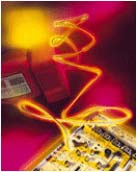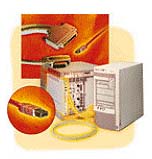What are you looking for?
Understanding FireWire
New Serial Interface Promises Easier, Faster, and Cheaper Instrument Control

Scaleable, flexible, and plug-and-play, FireWire (a.k.a. IEEE specification 1394.1995) is an ideal interface to connect instrumentation and computers. With advantages in performance, cost, and ease of use, here's what you need to know as you map out your company's test-system strategy over the next few years.
FireWire is a serial bus developed by Apple Computer and adopted by Microsoft and Intel as one of two serial buses that are part of the sealed PC concept-USB is the other serial bus and the two are considered complementary, with FireWire for high-speed devices requiring large digital data transfers and USB for low-speed peripherals such as keyboards and Modems. Microsoft has announced built-in support for FireWire in Windows 98 and NT 5.0. It is expected that FireWire will be built into motherboards in 1999.
Anticipating the shift of the PC industry to FireWire and USB, Keysight Technologies is beginning to provide instrumentation with FireWire ports and FireWire adapter cards for PCs.
High Performance
FireWire can achieve much higher speeds than conventional IEEE-488 (GPIB), which is typically specified as 1 megabyte/second (or 8 megabits/second). FireWire specifies three data rates that round to 100-, 200-, and 400 megabits/second. Devices with different data rates may be interconnected and communication is automatically configured to use the highest data rates supported.
In VXI systems, Keysight's VXI FireWire product (E8491B) is faster than the MXI bus for large block transfers.
Low Cost
FireWire's connectors and cables make it less expensive than parallel buses such as SCSI, Enhanced Parallel Port, and GPIB. The FireWire connector was created for the Nintendo Gameboy and provides field-proven reliability and durability. The cable's diameter is less than 0.25 inches and is flexible and durable.
A 4-meter FireWire cable costs around $20, while a 4-meter MXI/INTX cable costs around $465, and a 4-meter GPIB cable costs around $100. The price difference results from the number of wires that constitute the cable. A FireWire cable consists of six wires. Both MXI and GPIB are parallel buses and require many wires to pass information between instruments and the PC. Having fewer wires also makes the FireWire cable much more flexible than parallel bus cables.
Currently, FireWire I/O boards for PCs (E8491B, opt. 001) are about the same price as a high-performance GPIB card, which is about $500. In the future, FireWire will be built into computer motherboards, eliminating the need for additional I/O boards and so further reducing system costs.
Ease of Use

FireWire is a plug-and-play environment, and supports live connect/disconnect (i.e., hot plugging). You can connect devices in a daisy chain, tree, star, or combination. Using FireWire is as easy as plugging or unplugging a power cord. Imagine plugging an oscilloscope into your laptop PC, measuring a waveform, saving the data into a spreadsheet, and then unplugging the scope. That's the ease of use that FireWire will bring to design and test engineers.
FireWire and Instrumentation
FireWire is a computer and consumer industry standard. As instrument vendors provide FireWire ports to instruments, you will no longer need to add specialized instrument I/O boards to your PC to control instrumentation.
With FireWire, products such as digitizers, arbitrary function generators, digital pattern generators and other instruments that need to transfer large amounts of data will be able to do so without saturating the bus.
FireWire can also be used to create peer-to-peer networks. You could, for example, use a FireWire instrument to store data directly onto a FireWire hard drive without needing a computer.
VEE 5.0 supports FireWire. Visit VEE on the web for more information.
